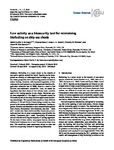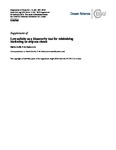Low salinity as a biosecurity tool for minimizing biofouling on ship sea chests
| dc.contributor.author | Trindade de Castro, Maria Cecilia | |
| dc.contributor.author | Vance, T | |
| dc.contributor.author | Yunnie, ALE | |
| dc.contributor.author | Fileman, TW | |
| dc.contributor.author | Hall-Spencer, Jason | |
| dc.date.accessioned | 2018-07-27T14:57:24Z | |
| dc.date.available | 2018-07-27T14:57:24Z | |
| dc.date.issued | 2018-07-18 | |
| dc.identifier.issn | 1812-0784 | |
| dc.identifier.issn | 1812-0792 | |
| dc.identifier.uri | http://hdl.handle.net/10026.1/11941 | |
| dc.description.abstract |
<jats:p>Abstract. Biofouling is a major vector in the transfer of non-native species around the world. Species can be transported on virtually all submerged areas of ships (e.g. hulls, sea chests, propellers) and so antifouling systems are used to reduce fouling. However, with increased regulation of biocides used in antifoulants (e.g. the International Maritime Organization tributyltin ban in 2008), there is a need to find efficient and sustainable alternatives. Here, we tested the hypothesis that short doses of low salinity water could be used to kill fouling species in sea chests. Settlement panels were suspended at 1.5 m depth in a Plymouth marina for 24 months by which time they had developed mature biofouling assemblages. We exposed these panels to three different salinities (7, 20 and 33) for 2 hours using a model sea chest placed in the marina and flushed with freshwater. Fouling organism diversity and abundance were assessed before panels were treated, immediately after treatment, and then 1 week and 1 month later. Some native ascidian Dendrodoa grossularia survived, but all other macrobenthos were killed by the salinity 7 treatment after 1 week. The salinity 20 treatment was not effective at killing the majority of fouling organisms. On the basis of these results, we propose that sea chests be flushed with freshwater for at least 2 hours before ships leave port. This would not cause unnecessary delays or costs and could be a major step forward in improving biosecurity.</jats:p> | |
| dc.format.extent | 661-667 | |
| dc.language | en | |
| dc.language.iso | en | |
| dc.publisher | Copernicus GmbH | |
| dc.title | Low salinity as a biosecurity tool for minimizing biofouling on ship sea chests | |
| dc.type | journal-article | |
| dc.type | Journal Article | |
| plymouth.author-url | https://www.webofscience.com/api/gateway?GWVersion=2&SrcApp=PARTNER_APP&SrcAuth=LinksAMR&KeyUT=WOS:000439239000001&DestLinkType=FullRecord&DestApp=ALL_WOS&UsrCustomerID=11bb513d99f797142bcfeffcc58ea008 | |
| plymouth.issue | 4 | |
| plymouth.volume | 14 | |
| plymouth.publication-status | Published online | |
| plymouth.journal | Ocean Science | |
| dc.identifier.doi | 10.5194/os-14-661-2018 | |
| plymouth.organisational-group | /Plymouth | |
| plymouth.organisational-group | /Plymouth/Faculty of Science and Engineering | |
| plymouth.organisational-group | /Plymouth/Faculty of Science and Engineering/School of Biological and Marine Sciences | |
| plymouth.organisational-group | /Plymouth/PRIMaRE Publications | |
| plymouth.organisational-group | /Plymouth/REF 2021 Researchers by UoA | |
| plymouth.organisational-group | /Plymouth/REF 2021 Researchers by UoA/UoA07 Earth Systems and Environmental Sciences | |
| plymouth.organisational-group | /Plymouth/Research Groups | |
| plymouth.organisational-group | /Plymouth/Research Groups/Marine Institute | |
| plymouth.organisational-group | /Plymouth/Users by role | |
| plymouth.organisational-group | /Plymouth/Users by role/Academics | |
| dc.identifier.eissn | 1812-0792 | |
| dc.rights.embargoperiod | Not known | |
| rioxxterms.versionofrecord | 10.5194/os-14-661-2018 | |
| rioxxterms.licenseref.uri | http://www.rioxx.net/licenses/all-rights-reserved | |
| rioxxterms.type | Journal Article/Review |



